How to choose an electric heated towel rail for the bathroom: selection tips and best options
The heated towel rail is a multifunctional accessory for the bathroom. It serves not only for drying towels, but also serves as a heater. A stylish model of modern design decorates the room, divides it into zones.
Devices vary in design, technical specifications, installation method. We will analyze in detail how to choose an electric heated towel rail for the bathroom, what parameters should you pay attention to.
The article is supplemented with information about the best manufacturers, whose products are in demand and have won positive customer reviews.
The content of the article:
Towel dryer - an indispensable device for the bathroom
An electric heated towel rail is a simple design of a bent pipe and a heating element connected to a power source. Features of the connection depend on the design of the model. The device itself is attached to the wall or mounted on the floor.
Most often, devices are bought for bathrooms, but sometimes they are appropriate in kitchens. Devices act as towel dryers and warm the air. The rooms of the bathrooms are usually small, so such a modest radiator is enough to create a comfortable temperature.
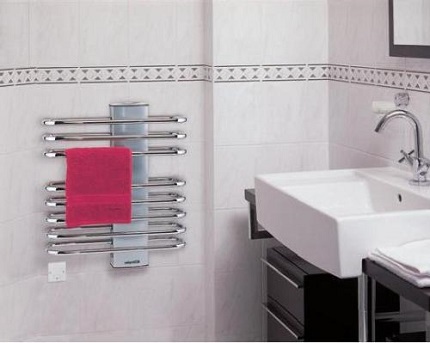
Regular heating of the bathtub prevents condensation and moisture. Thanks to this, the fungus multiplies less, which in a short time is able to completely spoil the finishing materials and even cause respiratory diseases in the residents of the house. Prevent education black mold easier than fighting it later.
A good heated towel rail is indispensable for any bathroom, especially in a house where there are small children. The main thing is to take into account all the features of the room and choose a device of suitable design and power.
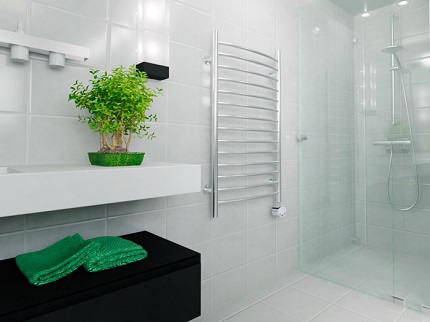
When is it better to use an electric model?
There are several types of heated towel rails - water, electric, combined. For a private house with autonomous heating systems and hot water supply, you can choose any option, but in an apartment with centralized heating, an electric or combined heated towel rail for the bathroom is more appropriate.
Water devices are connected to the domestic hot water system (imported ones are often designed for connection to heating). They are pipes through which hot water circulates.
In a private house, the owners themselves control the hot water supply, and apartment owners are deprived of this opportunity. They have water heated towel rails remain cold in the offseason, i.e. at a time when they are especially relevant.
It often happens that the temperature in the apartment is quite comfortable, but after a bath people feel chilly and can catch a cold. In such cases, it is impossible to do without an additional heating device in the bathroom.
The electric heated towel rail can be turned on exactly at the time when there really is a need for them.
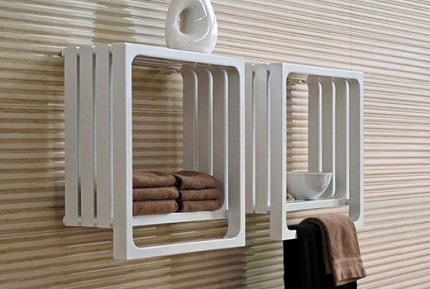
Advantages of electric coils
The list of arguments in favor of acquiring an electric device includes:
- Profitability. Devices consume a minimum of electricity, but their power is enough to warm the bathroom. The disadvantages include the fact that heated towel rails still consume electricity.
- No leaks. Water models corrode and sooner or later begin to leak. With dry-type electrical devices, nothing like this can happen.
- Wide design potential. Electric models are very diverse.There are stylish designer models that can become the main decoration of the bathroom.
- Pressure independence in communication systems. The effectiveness of water heated towel rails is largely dependent on pressure in the water supply system, sometimes they perform their functions worse due to air congestion. Electric models do not have these drawbacks.
- Minimum time outages. Power outages are common in many places, and this is a minus. However, there is a plus: if they happen, then for a short time. Outages with hot water occur less often, but can last for weeks until repair or preventive measures are over.
Another great advantage is the ability to easily change location. Moving the water device to another place is a laborious event, because The device is connected to a domestic hot water or heating system.
To transfer electric heated towel rail, just enough to rearrange the mount. It takes a few minutes.
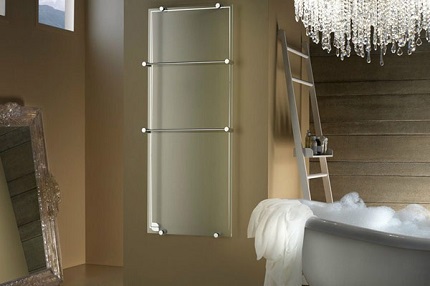
Electric heated towel rails are demanding to the installation site and power supply. Many breakdowns are associated precisely with non-compliance with the rules of connection and operation. Reveal and fix some problems succeed with his own hand.
Types of electric heated towel rails
Distinguish between “wet” and “dry” designs. In models of the first type, heating is carried out due to the coolant (water, antifreeze or oil), which is heated by the heater. By the principle of operation, they are similar to electric heaters.
Differences in principle of operation
Each type of coolant has its own advantages and disadvantages. The oil retains heat the longest after turning off the power, but the maximum possible temperature of an oil heated towel rail is 70 ° C. Water warms up to 85 ° C, but cools faster. Antifreeze is characterized by high thermal conductivity.
The advantages of “wet” devices include the ability to keep heat after being disconnected from the network. And the disadvantage is a greater energy consumption than dry towel warmers. Another disadvantage is the shorter life of the heating elements, as they wear out faster in liquids.
Models with a “dry” heating element are more durable than “wet” counterparts. On average, they last 3-5 years longer, although this largely depends on the quality of the materials and the assembly of the devices.
Devices of this type consume a minimum of electricity, and the range is more diverse, which expands the design capabilities of the owners of the premises.
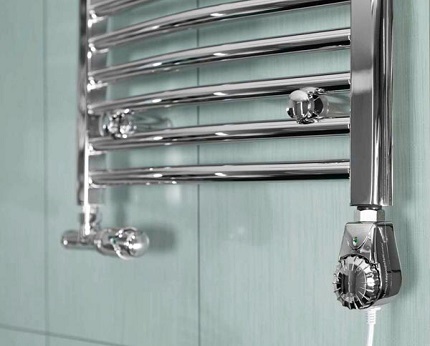
Form of execution of different models
There are heated towel rails of various configurations, and designer models sometimes simply amaze with elaborate designs. But with all the diversity there are two traditional forms - a snake and a ladder.
Owners of devices have long been convinced that, despite their simplicity, both types of devices are practical. What form should I prefer? Experts advise choosing a ladder.
There are several reasons for this:
- On the rungs of the heated towel rail, ladders, it is more convenient to place things for drying: they do not slip.
- Long things dry out faster because heating is carried out along their entire length.
- The heating area of such a device is larger, which means that the room will be better heated.
Snake-shaped towel rails have their own merits. They are cheaper because less materials are needed to make them. In addition, such models are more compact and less space is needed for their installation, which is important in conditions of a shortage of free space.
In many cases, it makes sense to buy a heated towel rail with sliding elements. When folded, it resembles a ladder, but the side parts can be taken to the sides and hang a few things on them. Shelf models are also convenient.
The final decision should be made after comparing prices, models and choosing a place for installation.
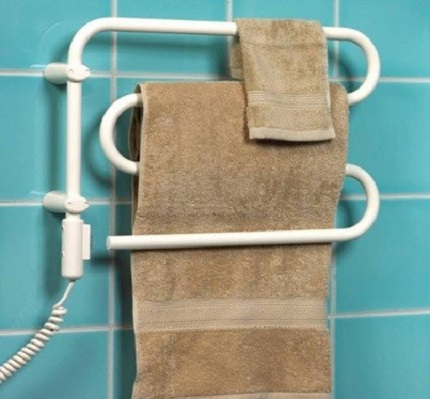
Wall and floor heated towel rails
Usually in bathrooms install wall mounted towel rails, and for cramped rooms this is the only right decision, because saves space. But if the area allows, you can choose a floor model, which has its own important advantages.
Outdoor electric models have appeared on the market relatively recently, but have already interested many buyers. They are designs combining the advantages of both heated towel rails and heaters. Devices are reliably protected from moisture and warm rooms effectively.
To install floor models, you do not need to drill the walls to mount the mounts: just put it in a convenient place and plug it into an outlet. The devices are equipped with stable legs, so they do not tip over. If necessary, the heated towel rail can be easily moved to another location.
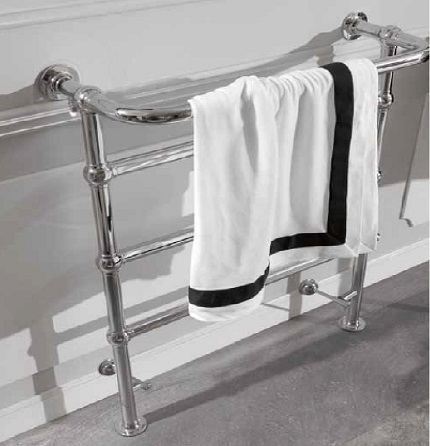
Which material should I prefer?
For the manufacture of electric heated towel rails, ferrous, stainless steel and non-ferrous metals are used. The cheapest models are made of black steel.
Outside, the devices almost do not differ from stainless steel products, and the inner surfaces of the tubes are coated with an anti-corrosion compound. Despite the processing, black steel is rather quickly destroyed, and this is a big minus.
Stainless steel models are versatile and suitable for almost any bathroom. Painted towel rails are cheaper than chromed ones, but they also lose their presentable appearance faster. When buying a stainless steel device, one should take into account the “capriciousness” of their threaded connections. It is better that such a heated towel rail is installed by a specialist.
Design models are often made of aluminum, copper or brass. Brass heated towel rails are extremely beautiful, have good heat transfer, but rarely turn out to be durable.
Copper models are almost flawless, but cost several times more expensive than devices made of other materials.
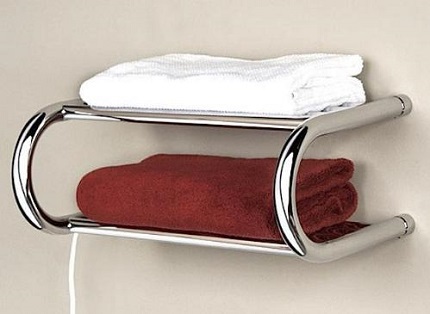
Landmarks of a competent choice
To the list of characteristics that you should focus on when choosing a heated towel rail include:
- Design and installation method. Typically, bathrooms do not differ in large sizes, and you have to place a large number of plumbing fixtures and furniture in them, so design is an important criterion for selection. Even before buying a device, you should consider where it will be installed, how it will fit into the interior of the room.
- Power. It is necessary to calculate this indicator so that for every square meter of the bathroom there is 150-200 watts of power. When installing less powerful models in the room, it will be damp, and an overly powerful device will cost more and waste energy.
- The way to connect the device to the network. Towel dryers are connected in open and hidden ways. With an open connection, wires from the device to an electrical outlet pass along the surface of the wall. When hidden - disguised as a finish. The first way to connect is much simpler, and the second is safer.
- Profitability. The power consumption of devices of various types can vary significantly. In heated towel rails installed heating elements with a capacity of 100-2000 watts. Powerful devices are often equipped with sensors, automation, which turns them off when the set temperature is reached. This allows more economical use of energy resources.
- Type of heating element. Typically, the power of devices with “dry” and “wet” TENs is the same, but the difference is only in the heating and cooling rates. Most often these are not fundamental indicators, but it is worth considering them.
- Additional functions. Some models include timers, temperature controllers and other useful functions.
We recommend paying attention to models with additional functions. Usually their cost is higher than that of "simple" heated towel rails, but such expenses pay off.
For example, people taking a shower before the start of the working day often set a timer half an hour before the rise, so that the bathroom warms up to a comfortable temperature in advance.

A temperature controller in a heated towel rail can be very useful for families with small children. The device maintains a constant temperature, so that at any time you can wash or bathe the baby in a warm bathroom and wipe it with a dry towel, while the energy is consumed extremely rationally.
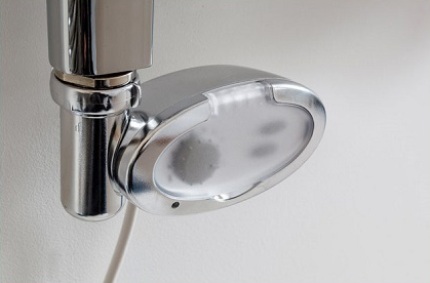
The best Russian and foreign manufacturers
The market for heated towel rails is diverse: you can find models of any quality, design, price, so you should pay special attention to the brand name and reputation of the manufacturer. Let's consider what electric towel rails our compatriots consider the best.
Italian company Margaroli produces models with power from 100 to 300 watts. All of them differ thoughtful design and increased comfort in use.
The best manufacturers:
- Kermi. Kermi heated towel rails are truly German quality and Swiss reliability. The Kermi brand has been known in the market for more than half a century and is already considered legendary. The main advantage of the technology of this brand is a reasonable price-quality ratio. Heated towel rails are made of good steel mainly in the form of a short flight of stairs. They are durable, reliable, stylistically neutral.
- Arbonia. Design radiators and heated towel rails of the Swiss company Arbonia are expensive, but the quality and appearance of the products are beyond praise. Models are made of steel. Antifreeze is used as a heat carrier for combined heated towel rails. You can manually adjust the heating temperature.
- Margaroli. Margaroli Italian brand equipment is not affordable for everyone. Towel dryers of this brand are made of high quality expensive materials, equipped with automation. There are brass appliances. Distinctive features of the Margaroli technique are their sophisticated design and durability. The manufacturer is so confident in the quality of the products that it gives a 15-year warranty.
- Energy. Energy Group is one of the leaders in the European heating technology market. The manufacturer produces durable high-quality devices. Design - any: in the assortment of flat, three-dimensional, rotary models of various configurations. The Energy U G3K heated towel rail is especially popular as combines good technical characteristics and reasonable price.
- "Sunergea." The Russian company produces elite models of heated towel rails, which have found demand not only in the domestic, but also in the European market. The models are diverse in design, made of stainless steel with a durable shiny coating.Warranty for SUNERZH products is 5 years.
- "Dvin." The Russian company “Dvin” has released more than 30 series of heated towel rails made of polished stainless steel. Most of the models are made in the form of a ladder. The manufacturer gives a 1 year warranty on their products.
- "Nika". Electric towel warmers of the Nika trademark are known in the market more than 10 years. Customers value branded products for their good quality and stylish designs. The company does not produce rotary models, but there are many interesting heated towel rails with shelves. The warranty on the products of this company is 5 years.
- Terminus. The main advantage of heated towel rails of the Russian Terminus brand is a wide selection of models. Among them are both budgetary and expensive. Towel dryers are made of steel 2 mm thick. Models are distinguished by high performance and stylish design. The manufacturer gives a guarantee of 10 years.
- Leader Steel. Many customers prefer Leader-Steel products. Towel dryers are made of stainless steel, it is possible to adjust the heating temperature from 30 to 70 degrees. In case of overheating or overcooling, the devices turn off automatically. The manufacturer gives a 5-year warranty.
- Terma. The Polish company Terma has been known in the market for more than a quarter of a century. During this time, she gained popularity among our compatriots.
Terma heated towel rails are made of high-quality steel and equipped with temperature regulators.
A number of manufacturers produce besides electric, water and combined models.
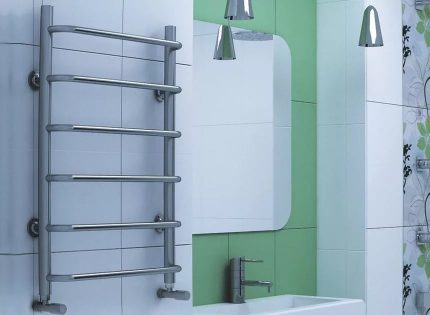
Conclusions and useful video on the topic
Design features and advantages of electric heated towel rails are discussed in the video below:
We offer a video in which the pros and cons of heated towel rails of various types are described in detail:
Overview of devices from the Sunerge brand:
The choice of heated towel rail depends on the priorities and personal preferences of the buyer. The main thing is to pay attention to product quality and carefully read the technical documentation.
If the model is chosen correctly, there will be no problems with it, because the installation of devices is elementary, and the towel warmers themselves are very easy to operate. If you still have difficulties, you can consult with specialists.
Looking for a practical electric heated towel rail? Or have experience using such installations? Please leave comments on the article and share your impressions about the operation of heated towel rails.

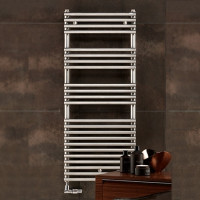 How to choose a heated towel rail for the bathroom: what to look at before buying + an overview of popular brands
How to choose a heated towel rail for the bathroom: what to look at before buying + an overview of popular brands 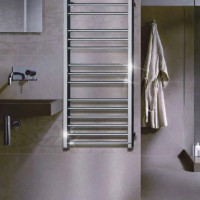 Which water heated towel rail is better: learning how to choose the right one
Which water heated towel rail is better: learning how to choose the right one 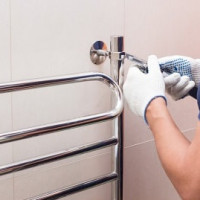 How to connect a heated towel rail to the DHW riser and a heating circuit with your own hands
How to connect a heated towel rail to the DHW riser and a heating circuit with your own hands 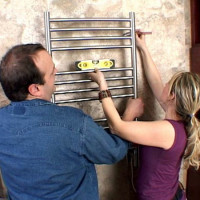 Installing a heated towel rail in the bathroom: DIY installation guide
Installing a heated towel rail in the bathroom: DIY installation guide 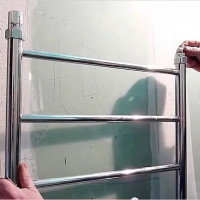 Transfer the heated towel rail to another wall in the bathroom: installation instructions
Transfer the heated towel rail to another wall in the bathroom: installation instructions 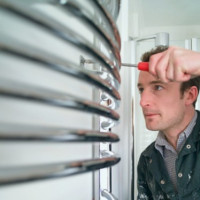 How to replace a heated towel rail in a bathroom according to the rules
How to replace a heated towel rail in a bathroom according to the rules  How much does it cost to connect gas to a private house: the price of organizing gas supply
How much does it cost to connect gas to a private house: the price of organizing gas supply  The best washing machines with dryer: model rating and customer tips
The best washing machines with dryer: model rating and customer tips  What is the color temperature of light and the nuances of choosing the temperature of the lamps to suit your needs
What is the color temperature of light and the nuances of choosing the temperature of the lamps to suit your needs  Replacement of a geyser in an apartment: replacement paperwork + basic norms and requirements
Replacement of a geyser in an apartment: replacement paperwork + basic norms and requirements
It seems to me that electric heated towel rails were invented by designers, not engineers. Their main advantage is the variety of shapes and their arrangement in the bathroom. And another plus is the possibility of autonomous use, even if the heating is turned off. I do not think that this significantly increases the consumption of electricity due to the electrical appliance constantly included in the network. When choosing, I would pay more attention not to the limits of consumption, but to reliability, if it can somehow be determined from the parameters that manufacturers give.
How lucky I am with you! For some time now, the problem has been dragging on: because of a leak, they removed an old water heated towel rail and extended an ordinary pipe from floor to ceiling (I live in a high-rise building). It’s very expensive to install a new similar device: both for it and for work. And if you buy an electric, and even floor, it will cost if not cheaper, then certainly without hassle.
Those who think that the energy consumption for the operation of a heated towel rail is not significant are mistaken. 200W * 24h * 30days = 144 kWh per month. Of course, to someone this is nonsense. I don’t. But still a heated towel rail is needed. And rightly said: reliability is important. And further. I read the reviews. People more often think about price, convenience, design. People!!! Think safety first! Imagine yourself or a child holding (s) a hand clenched from electric current for a towel warmer broken by phase (yes, any electrical appliance in the bathroom and not only). You won’t be able to unclench your hand (by the way, sometimes people think that the tile is an insulator. They’re wrong). Imagine, and try to take all measures to prevent this.
First they write that it consumes no more than a light bulb, and then they say about the required power of 200 W per square area, i.e. 500-600 watts per small bathroom. This is not “engineer.techinfus.com/en/”, but the advice of an idiot.
Such a normal 500-watt bulb = D In general, electric heating has always been the most expensive. More economical than a water heated towel rail has not yet been invented, and an electric one should be installed only if there are no options to connect a water heater.
I bought an electric Bohemia-8 heated towel rail with a temperature controller - after three months, the average consumption is 200 rubles per month. The temperature regulator automatically turns off, maintaining the temperature at the desired level, which is why it is energy-saving.
It was very important for me not to run into Chinese, since my friends bought one, and not even a year had to be changed - it rusted everything and even started to drip in one place. I read reviews on the Internet, and ordered myself from our Ukrainian manufacturer. Very pleased, no problems arise. Heats the bathroom with high quality, despite the fact that I have far from small sizes.
At home, an electric heated towel rail, consumes 60 watts. The room has become significantly warmer. The size of the bathroom is 1.7x1.7m.